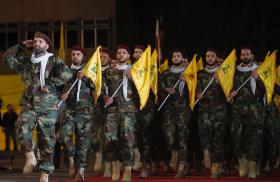
- Policy Analysis
- PolicyWatch 3895
Hezbollah-Israel Escalation: Prospects for War

A former Israeli military planner joins three experts to discuss each side’s current calculus and the U.S. policy implications if they opt for war or a truce.
On June 28, The Washington Institute held a virtual Policy Forum with Matthew Levitt, Hanin Ghaddar, David Schenker, and Assaf Orion. Levitt is the Institute’s Fromer-Wexler Senior Fellow and director of its Reinhard Program on Counterterrorism and Intelligence. Ghaddar is the Institute’s Friedmann Senior Fellow and co-creator of its interactive map tracking clashes along the Israel-Lebanon border. Schenker is the Institute’s Taube Senior Fellow and director of its Rubin Program on Arab Politics. Orion is the Institute’s Rueven International Fellow and former head of the Israel Defense Forces Strategic Planning Division. The following is a rapporteur’s summary of their remarks.
Matthew Levitt
Tensions between Hezbollah and Israel were building well before the Gaza war. Despite primarily focusing on Syria in recent years, the group has continually invested in its ability to strike Israel by digging tunnels and developing missile systems. It began reasserting itself along the border two years ago; since October 7, it has pledged to fight Israel in solidarity with Gaza. Another key reason behind the most recent escalation is that Israel can no longer tolerate Hezbollah firing rockets and drones across the border on a near-daily basis. The government is keen on getting citizens back to their homes in the north before the new school year begins this fall.
If the parties move to full-scale war, it would be even more destructive than the fighting in Gaza. Secretary-General Hassan Nasrallah warned that Hezbollah would fight with “no restraint, no rules, no ceilings,” and both sides have vowed to inflict massive damage. In such a war, Hezbollah could claim victory simply by surviving, and by noting that its attacks largely depopulated the border area of Jews for many months—a likely theme of its next big anti-Israel propaganda campaign. For Israel, victory would mean pushing the group back around seven to ten kilometers from the border and destroying enough of its fighting power so that evacuees can return home.
Diplomacy is unlikely to forestall deeper conflict between the two sides, especially in the long term. By vowing to fight Israel until a ceasefire is reached in Gaza, Nasrallah effectively gave Hamas commander Yahya al-Sinwar veto power over any near-term de-escalation along Lebanon’s border. Hezbollah is also unlikely to accept a diplomatic solution so long as it believes it can maintain the current tempo of fighting without risking full-fledged war.
In Israel, the October 7 attack completely changed the country’s perspective on external security threats, making it less likely to accept a perpetual Hezbollah threat on its border or a diplomatic solution that simply kicks the can down the road regarding the group’s massive rocket and missile arsenal. Accordingly, as the conflict escalates, the U.S. role should be twofold: (1) to deter direct, large-scale Iranian involvement, if necessary through concerted joint military action of the sort seen when Tehran launched a direct strike on Israel this April, and (2) to target supply routes between Iran and its proxies more aggressively.
Hanin Ghaddar
Hezbollah’s escalation has been linked to the phases of the Gaza war, indicating that the group wants to be part of postwar negotiations between Israel and the Palestinians. It began using more advanced weapons after Iran’s April attack on Israel, though it has not yet deployed its most potent systems. More recently, it escalated its attacks rapidly in response to Israel’s offensive in Rafah and the Biden administration’s proposal of a three-step plan for Gaza.
Hezbollah’s calculations are linked to Iran’s because, unlike other proxies, it is organically connected to the regime’s Islamic Revolutionary Guard Corps-Qods Force and plays a role in Tehran’s decisionmaking process, albeit a subsidiary one. Iran does not want to be directly involved in the current conflict and will only intervene if Israel threatens its nuclear program or its hold on political power. In that sense, Hezbollah also acts as the regime’s insurance policy, providing a deterrent against Israel and protection for Iranian assets inside Lebanon.
Regarding the current international push for a diplomatic solution, officials should focus on reaching a ceasefire between Hezbollah and Israel to avoid a large-scale conflict. Past initiatives that reached for broader goals—such as UN Security Council Resolution 1701, which prohibited Hezbollah from maintaining a presence south of the Litani River—have repeatedly failed because international peacekeeping forces and the Lebanese military were not up to the task of enforcement. A long-term diplomatic solution requires reestablishing state sovereignty in Lebanon, principally through Security Council Resolution 1559, which called for countering smugglers along the Lebanon-Syria border and reducing Hezbollah’s ability to act as a military power at home. A ceasefire with Israel cannot survive indefinitely without addressing these concerns over smuggling and sovereignty.
David Schenker
Israel’s main goal is to push Hezbollah’s densely deployed elite units, the Radwan Force, away from the border. Since October, when Hezbollah increased its attacks along the frontier, Israel has been specifically targeting the group’s key personnel and assets in southern Lebanon and the Beqa Valley, inflicting an estimated $1.5 billion worth of damage. As in Israel, nearly 70,000 Lebanese residents have fled their homes in the area and moved north, seeking shelter in government housing or with relatives. Despite this civilian suffering, however, Hezbollah has not faced concerted pressure from its constituency to end the escalation.
For some time now, the group has come to view Israel as divided and weak due to several factors—the status of the Gaza war, domestic protests over the military draft law, perceived divisions with Washington, increased isolation on the international stage, and political rifts of the sort that recently led popular official Benny Gantz to resign from Prime Minister Binyamin Netanyahu’s war cabinet. As such, Hezbollah and Iran may be content with the present situation. Notably, however, Nasrallah widened his threats last month to include Cyprus, potentially forecasting the group’s willingness to attack commerce in the Mediterranean Sea like the Iran-backed Houthis are doing in the Red Sea.
The success of U.S. diplomatic efforts in Lebanon will depend on what occurs after Israel declares an end to “major combat operations” in Gaza. A formal ceasefire with Hamas seems unlikely—would an informal wind-down in Israel’s Gaza operations be sufficient for Hezbollah to end its campaign in the north? And would the militia be willing to withdraw its Radwan Force to the Litani River?
Other controversial issues will affect diplomacy as well. Perhaps the most glaring one is the UN Interim Force in Lebanon, which has long been an ineffective monitoring mechanism and is unlikely to improve. Deploying the Lebanese Armed Forces to the south would not help much either—the LAF has a history of colluding with Hezbollah and obstructing UNIFIL, and it will never act against Hezbollah’s interests.
If a wider war does erupt, the United States is committed to supporting Israel with munitions and intelligence. It would also have to help the country counter a likely increase in long-range Houthi missile and drone attacks against Israeli targets.
Assaf Orion
All areas in northern Israel within five kilometers of the Lebanese border have become a war zone, witnessing daily Hezbollah attacks on various towns. So far, however, the group has avoided striking highly populated areas, instead targeting military facilities. As such, many Israeli officials have come to regret evacuating the area last year.
The current plan for returning citizens to the north includes stopping the daily fighting, pushing Hezbollah back from the border, and deploying heavier defenses along the frontier. The difficulty will be aligning Israel’s political and military apparatus, which have largely differed on security tactics.
Iran presents another significant challenge, as it appears to have entered a new stage of aggression and risk-taking in support of its proxies. Under these circumstances, certain parties could accidentally stumble into a war, especially now that Hezbollah and Tehran are overconfident about their ability to inflict damage on Israel.
In deciding how to proceed, Israel essentially has three options: move to full-fledged war against Hezbollah, continue the current strategy of targeted operations, or reach a diplomatic solution. The requirements for the latter track are clear: Beirut must reestablish state control in southern Lebanon, and the international community must acknowledge the need to destroy Iranian supply lines to its proxies, the main problem underlying recent cycles of escalation. Realistically, a diplomatic agreement would only resolve the current circumstances of active conflict—it is unlikely to address underlying problems such as Hezbollah deployments south of the Litani or the group’s acquisition of advanced weapons from abroad. As such, the agreement would only last until Nasrallah believes he can safely attack Israel again.
This summary was prepared by Timothy McGill. The Policy Forum series is made possible through the generosity of the Florence and Robert Kaufman Family.






